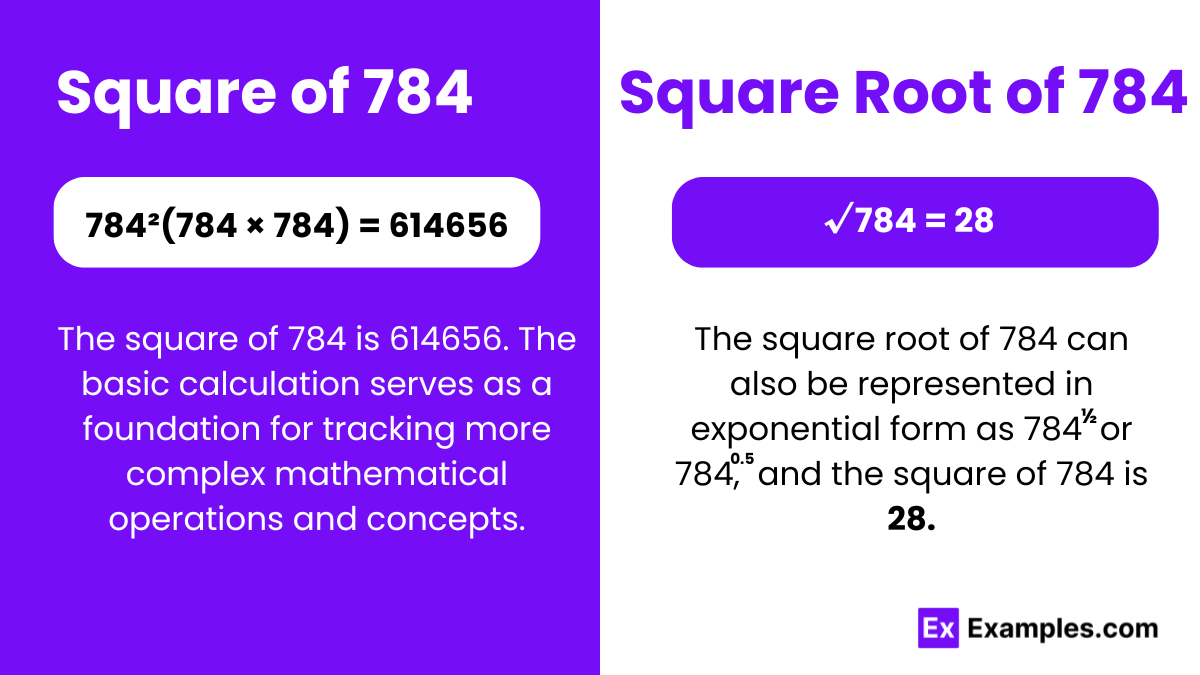What is the square of 784?
625
784
4096
576


In the realm of mathematics, especially in algebra, squares and square roots play a crucial role. Squaring a number, as shown by multiplying 784 by itself to yield 614,656, is fundamental. This operation explores properties of rational and irrational numbers, enhancing understanding of mathematical relationships and patterns, crucial for advanced mathematical insights.
784²(784 × 784) = 614656
The square of 784 is calculated by multiplying the number by itself, resulting in 614,656. This calculation (784 squared = 784 × 784) demonstrates how squaring amplifies the magnitude of a number, reflecting its exponential increase in mathematical and practical applications.
√784 = 28
The square root of 784 is 28, which is derived by identifying the number that, when multiplied by itself, equals 784. This calculation is straightforward since 784 is a perfect square, formed from 28 squared (28 × 28 = 784). Understanding this helps in solving equations and understanding mathematical concepts that involve square roots and their properties.
Square Root of 784: 28
Exponential Form of 784: (784)½ or or (784)0.5
Radical Form of 784: √784
The square root of 784 is rational.
The square root of 784 is a rational number. This classification is based on the ability to express a number as a fraction where both the numerator and the denominator are integer, and the denominator is not zero.
A rational number is considered if it can be written as a fraction 𝑝/𝑞, where 𝑝 and 𝑞 are integers and 𝑞 is not zero. The square root of 784, which is 28, fits this definition perfectly because it can be expressed as 28/1.
In contrast, an irrational number cannot be expressed as a simple fraction. It is a number that has a non-repeating, non-terminating decimal expansion. Examples include 𝜋 and 2. These numbers cannot be precisely expressed as a fraction of two integers. The square root of 784, being 28, does not fall into this category, as it can be precisely expressed as a fraction.
Finding the square root of a number involves determining the value that, when multiplied by itself, gives the original number. For example, the square root of 784 is the value that, when multiplied by itself, equals 784. There are various methods to find the square root of a number, ranging from simple arithmetic techniques to more complex mathematical algorithms.
1. Prime Factorization: Express 784 as a product of prime numbers (2 × 2 × 2 × 2 × 7 × 7), then take one factor from each pair of identical primes, giving you the square root of 784 as 22×7=28
2. Repeated Subtraction: Start with a number close to the square root of 784 (e.g., 27). Subtract it from 784 and adjust the number based on the result until you get 0. This iterative process yields the square root, which is 28.
3. Guess and Check: Estimate the square root of 784 (e.g., 27 or 29) and square it. Adjust your guess based on whether the result is too high or too low until you find the correct value, which is 28.
4. Using a Calculator: Simply input √784 into a calculator, and it will give you the result directly, which is 28.
5. Geometric Method: Draw a square with an area of 784 square units. Then, find the side length of the square, which is the square root of 784, giving you a value of 28 units.
6. Binomial Theorem: Expand (𝑎+𝑏)2=784, where 𝑎=𝑏. Solving this equation yields a value of 𝑎=28, which is the square root of 784.
Using Tables: Refer to precomputed tables of square roots to find the value corresponding to 784, which is 28.

Yes, 784 is a perfect square
Yes, 784 is a perfect square. It is the square of 28, as 28×28=78428×28=784. When a number can be expressed as the product of an integer with itself, it is referred to as a perfect square. In this case, 784 meets that criteria perfectly.
Yes, the square root of any positive real number has two values: one positive and one negative. Thus, the square root of 784 can also be -28, although the principal square root (commonly referred to in most contexts) is 28.
Squares and square roots are used in real life for various purposes, such as computing areas, architectural design, in physics for calculations involving laws of motion and energy, and in statistics for calculating standard deviations.
Errors can occur due to incorrect pairing of digits, mistakes in subtraction, choosing the wrong digit in the long division method, or simply due to miscalculations at any step. Accuracy in each step is crucial to ensure the correct result.
784 is an even number, and it is divisible by several numbers: 1, 2, 4, 7, 8, 14, 16, 28, 49, 56, 98, 112, 196, 392, and 784. It’s also the product of 24×7224×72, making it a rich number in terms of factors.
Text prompt
Add Tone
10 Examples of Public speaking
20 Examples of Gas lighting
What is the square of 784?
625
784
4096
576
What is the square root of 784?
28
30
32
34
If you square the square root of 784, what will you get?
456
567
678
784
Which number squared gives 784?
25
28
30
32
What is the value of 784¹/²?
14
28
56
58
What is 784 raised to the power of 0.5?
528
628
28
784
If the square root of 784 is multiplied by itself, what is the result?
568
689
784
892
Which of the following is true about the square of 784?
It is less than 784
It is equal to 784
It is greater than 784
It is half of 784
What is the value of√784 × √784?
584
784
884
984
f you take the square of 28, what is the result?
784
786
788
790
Before you leave, take our quick quiz to enhance your learning!

